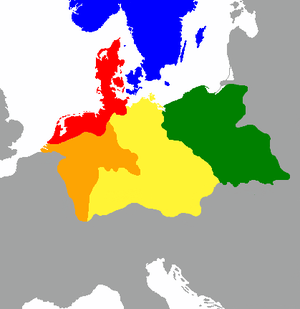Istvaeones
| Istvaeones | |
|---|---|
| Geographic distribution: | Netherlands, northern Belgium, northern France, western Germany, Suriname, Netherlands Antilles, Aruba, Namibia and South Africa |
| Linguistic classification: |
|
| Proto-language: | Old Frankish |
| Subdivisions: | |
| Glottolog: | wese1235[1] |
|
The distribution of the primary Germanic dialect groups in Europe in around AD 1:
Weser-Rhine Germanic, or Istvaeonic
| |
The Istvaeones, also called Istaevones, Istriaones, Istriones, Sthraones, and Thracones, are mentioned as a Germanic tribal grouping in the writings of Tacitus and Pliny the Elder (~1st century AD). They categorized them as one of the nations of Germanic tribes descended from one of the sons of Mannus, a Germanic ancestor. The other two such peoples were the Ingvaeones and Irminones.
The Low Franconian languages, such as Dutch, are sometimes referred to as Istvaeonic languages because they are associated with a similar geographical area, although they appear only some centuries later than the reports of Tacitus and Pliny. (Whether the original Istvaeones of Tacitus and Pliny spoke a language ancestral to modern Istvaeonic is not certain, but it is possible. Some of the "Germanic" tribes living near the Rhine in that era may not even have spoken a Germanic language.)
Tacitus, in his Germania (chapter 2) writes
In their ancient songs, their only way of remembering or recording the past, they celebrate an earth-born god, Tuisco, and his son Mannus, as the origin of their race, as their founders. To Mannus they assign three sons, from whose names, they say, the coast tribes are called Ingævones; those of the interior, Herminones; all the rest, Istævones. Some, with the freedom of conjecture permitted by antiquity, assert that the god had several descendants, and the nation several appellations, as Marsi, Gambrivii, Suevi, Vandilii, and that these are genuine old names.[2]
Pliny the Elder writes that there are five races of Germania, one of which is the Istævones, who live near the Rhine.[3]
Jacob Grimm in the book Deutsche Mythologie argued that Iscaevones was the correct form, partly because it would connect the name to an ancestor figure in Norse mythology named Ask, and partly because in Nennius where the name Mannus is corrupted as Alanus, the ancestor of the Istaevones appears as Escio or Hisicion. There the sons of this figure are, fantastically, from Frankish tradition, Francus, Romanus, Alamanus, and Bruttus, the supposed ancestors of the Franks, Latins, Germans and Britons. This seems to reflect Frankish desire to connect the Franks with the people they ruled.
References
- ↑ Hammarström, Harald; Forkel, Robert; Haspelmath, Martin; Bank, Sebastian, eds. (2016). "Low Franconian (Weser–Rhine)". Glottolog 2.7. Jena: Max Planck Institute for the Science of Human History.
- ↑ Tac. Ger. 2
- ↑ Plin. Nat. 4.28
Further reading
- Grimm, Jacob (1835). Deutsche Mythologie (German Mythology); From English released version Grimm's Teutonic Mythology (1888); Available online by Northvegr © 2004-2007:Chapter 15, page 2-; 3. File retrieved 11-18-2015.
- Tacitus, Germania (1st Century AD). (in Latin)
- Friedrich Maurer (1942) Nordgermanen und Alemannen: Studien zur germanische und frühdeutschen Sprachgeschichte, Stammes- und Volkskunde, Strasbourg: Hünenburg.
